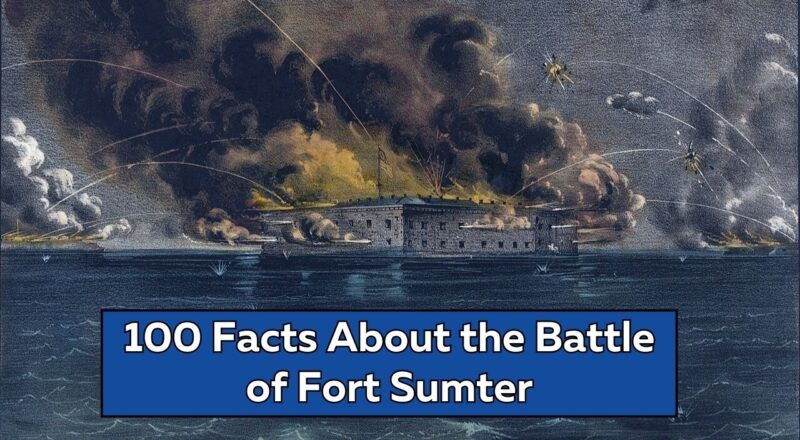The Battle of Fort Sumter marked the beginning of the American Civil War, a pivotal moment in United States history. This conflict, which took place in 1861, shaped the nation’s future in profound ways. But learning about history doesn’t have to be boring! Let’s explore 100 fascinating facts about the Battle of Fort Sumter in a fun and engaging way.
Fort Sumter Basics
- Location: Fort Sumter is located in Charleston Harbor, South Carolina.
- Construction: It was originally built as a coastal defense fort in the 1820s.
- Name Origin: The fort was named after General Thomas Sumter, a hero of the American Revolutionary War.
The Lead-Up to Battle
- Secession: South Carolina was the first state to secede from the Union in December 1860.
- Fort in Confederate Hands: By early 1861, South Carolina had seized control of Fort Sumter.
Union vs. Confederate
- Union Commander: Major Robert Anderson led the Union forces stationed at Fort Sumter.
- Confederate Commander: General P.G.T. Beauregard was in charge of the Confederate forces.
The Battle Begins
- April 12, 1861: The battle started when Confederate forces opened fire on Fort Sumter.
- Duration: The battle lasted for 34 hours.
Bombardment
- Shells Fired: During the battle, more than 3,000 shells were fired at Fort Sumter.
- No Casualties: Surprisingly, no one was killed during the bombardment.
Surrender
- Surrender: The Union forces surrendered on April 13, 1861.
- Terms of Surrender: The Union soldiers were allowed to leave the fort with their weapons and the U.S. flag.
Historical Significance
- Turning Point: The Battle of Fort Sumter is considered the beginning of the American Civil War.
- Symbolic Flag: The Confederate flag that flew over Fort Sumter became a symbol of the Confederacy.
Famous Figures
- Abraham Lincoln: President Lincoln ordered a naval expedition to resupply Fort Sumter, leading to the battle.
- Jefferson Davis: He was the President of the Confederate States of America during the battle.
The Aftermath
- Four Years of War: The Civil War lasted for four years, ending in 1865.
- Emancipation Proclamation: In 1863, President Lincoln issued the Emancipation Proclamation, which eventually led to the abolition of slavery.
Civil War Innovations
- Ironclad Ships: The Civil War saw the introduction of ironclad warships, like the USS Monitor.
- Submarines: The Confederate submarine, the CSS Hunley, was used during the war.
Impact on the Nation
- Reconstruction Era: After the Civil War, the country underwent a period of reconstruction to heal and rebuild.
- 13th Amendment: The 13th Amendment to the Constitution abolished slavery in the United States.
Fort Sumter Today
- National Monument: Fort Sumter is now a National Monument, preserving its historical significance.
- Visitors: You can visit Fort Sumter to learn more about this important event in American history.
Fun Facts
- Civil War Music: Both Union and Confederate troops had their own songs and music to boost morale.
- Civil War Medicine: Medical practices during the Civil War were far less advanced than today.
Civil War Food
- Hardtack: Soldiers ate hardtack, a type of hard bread, as a staple food.
- Beans and Bacon: Another common meal for soldiers was beans and bacon.
Telegraph Communication
- Telegraph Lines: Telegraph communication played a crucial role in relaying wartime information.
- Signal Corps: The Union Army had a Signal Corps responsible for transmitting messages.
Women in the War
- Nurses: Many women served as nurses during the Civil War, caring for wounded soldiers.
- Spies: Some women worked as spies, gathering intelligence for their respective sides.
Technology
- Photography: Civil War photography, though limited, captured the war’s brutality and reality.
- Balloon Observations: Balloons were used for observation, providing valuable insights into enemy movements.
Famous Battles
- Gettysburg: The Battle of Gettysburg was one of the most significant battles of the Civil War.
- Antietam: The Battle of Antietam was the bloodiest single-day battle in American history.
Generals and Leaders
- Ulysses S. Grant: He became a prominent Union general and later President of the United States.
- Robert E. Lee: A respected Confederate general, Lee led the Army of Northern Virginia.
Fort Sumter’s Legacy
- Historical Legacy: Fort Sumter remains an enduring symbol of the American Civil War.
- National Park Service: The National Park Service preserves Civil War battlefields and sites.
Military Strategies
- Trench Warfare: Trenches were commonly used in battles, leading to stalemates.
- Blockade Runners: Ships attempted to break through Union blockades to deliver supplies to Confederate ports.
Personal Stories
- Soldiers’ Letters: Many soldiers wrote letters home, providing insight into their experiences.
- Brother vs. Brother: The Civil War sometimes pitted family members against each other due to differing loyalties.
International Involvement
- Foreign Observers: Several foreign nations sent observers to witness the Civil War.
- British Neutrality: Despite tensions, Britain maintained a policy of neutrality.
Civil War Economics
- Economic Impact: The Civil War had a profound impact on the American economy.
- Inflation: Prices for everyday goods soared during the war.
Music and Entertainment
- Brass Bands: Brass bands played music to boost morale and entertain troops.
- Minstrel Shows: Minstrel shows, though racially insensitive, were popular entertainment during the war.
Medicine Advancements
- Amputations: Amputations were common due to the severity of battlefield injuries.
- Field Hospitals: Field hospitals provided medical care for wounded soldiers.
Life on the Homefront
- War Bonds: Citizens bought war bonds to support the war effort.
- Rationing: Food and resources were often rationed to support the troops.
Fort Sumter’s Evolution
- Reconstruction: After the war, Fort Sumter was repaired and upgraded.
- World War II: The fort was used as a military post during World War II.
The Civil War’s End
- Appomattox Court House: The Confederate surrender at Appomattox Court House effectively ended the war.
- Lincoln’s Assassination: President Lincoln was assassinated by John Wilkes Booth in April 1865.
Legacy of Freedom
- Civil Rights: The Civil War laid the groundwork for the civil rights movement in the United States.
- Martin Luther King Jr.: Dr. Martin Luther King Jr. drew inspiration from the Civil War for his fight for racial equality.
The Gettysburg Address
- Lincoln’s Speech: President Lincoln delivered the famous Gettysburg Address in November 1863.
- A New Birth of Freedom: Lincoln spoke of a “new birth of freedom” for the United States.
Memorializing the Fallen
- Gettysburg National Cemetery: Many Civil War soldiers are buried in this cemetery.
- Unknown Soldiers: Some graves contain unknown soldiers, a testament to the war’s toll.
Notable Women
- Clara Barton: Clara Barton, the founder of the American Red Cross, tended to wounded soldiers during the war.
- Harriet Tubman: The famous abolitionist worked as a nurse, cook, and spy during the Civil War.
Art and Literature
- Civil War Art: Many artists depicted scenes from the war, including Winslow Homer.
- Civil War Literature: Authors like Louisa May Alcott wrote about their experiences during the war.
Civil War Reenactments
- Living History: Civil War reenactments bring history to life for modern audiences.
- Historical Accuracy: Reenactors strive for authenticity in clothing, weapons, and tactics.
Modern Perspective
- Civil War Studies: The Civil War remains a popular subject for historical research.
- Civil War Museums: Museums across the United States showcase artifacts from the war.
The End of Slavery
- 13th Amendment: The 13th Amendment to the U.S. Constitution, passed in 1865, abolished slavery.
- Emancipation Proclamation: President Lincoln’s Emancipation Proclamation declared enslaved people in Confederate territory to be free.
Impact on African Americans
- Union Army: Thousands of African Americans served in the Union Army.
- Buffalo Soldiers: After the Civil War, some African American soldiers became known as Buffalo Soldiers.
Civil War Diplomacy
- Foreign Relations: The Civil War affected international diplomacy and trade.
- Cotton Diplomacy: The South’s attempt to gain support from European powers through cotton failed.
Reconstruction Challenges
- Rebuilding the South: Reconstruction aimed to rebuild the Southern states after the war.
- Challenges Ahead: Reconstruction faced many obstacles, including racial tensions.
Battlefield Preservation
- Preserving History: Organizations like the Civil War Trust work to protect and preserve battlefields.
- Tourism: Civil War battlefields attract tourists and history enthusiasts.
Civil War Poetry
- Walt Whitman: The poet Walt Whitman served as a nurse during the Civil War.
- “O Captain! My Captain!”: Whitman’s famous poem mourns the death of President Lincoln.
The Role of Religion
- Spiritual Comfort: Religion played a significant role in providing comfort to soldiers.
- Chaplains: Chaplains provided spiritual guidance to troops on both sides.
Civil War Technology
- Spencer Repeating Rifle: This rifle gave Union soldiers an advantage with its rapid fire.
- Telegraph Lines: Telegraph lines were used to relay orders and information.
Civil War Artifacts
- Uniforms: Soldiers wore distinctive uniforms, making it easy to identify their side.
- Canteens: Soldiers used canteens to carry water during marches and battles.
Lessons Learned
- Reconciliation: The United States has worked to reconcile and heal the divisions caused by the Civil War.
- Civil Rights Movement: The struggle for civil rights in the 20th century drew inspiration from the Civil War.
Civil War Legends
- Stonewall Jackson: Confederate General Stonewall Jackson earned his nickname for standing “like a stone wall” in battle.
- John Brown: Abolitionist John Brown’s raid on Harpers Ferry in 1859 was a precursor to the war.
Historical Memory
- Memorial Day: Memorial Day, originally Decoration Day, began as a way to honor Civil War soldiers.
- Civil War Reconciliation: Veterans from both sides later worked to reconcile and remember the war.
Conclusion
The Battle of Fort Sumter and the Civil War left an indelible mark on American history. Learning about this pivotal event can be both educational and enjoyable. So, the next time you visit a historical site or read a book about the Civil War, remember these 100 facts and let them bring history to life.




